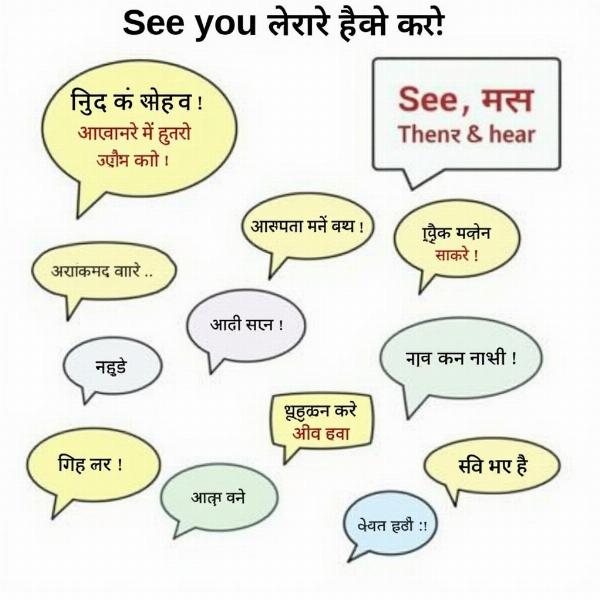Understanding the nuances of translating phrases like “see you then” into Hindi can be tricky. It’s not just about finding a literal translation, but also about capturing the right tone and cultural context. This guide will explore various ways to say “see you then meaning in hindi,” providing you with a comprehensive understanding of the subtle differences and appropriate usage in different situations.
Different Ways to Say “See You Then” in Hindi
There isn’t one single perfect translation for “see you then” in Hindi. The best option depends on the level of formality, the specific context, and the relationship with the person you’re speaking to. Here are some common translations and their nuances:
- फिर मिलते हैं (Phir milte hain): This is the most common and versatile translation. It literally means “we will meet again” and can be used in both formal and informal settings. It carries a sense of general pleasantness and is suitable for most situations.
- तब मिलते हैं (Tab milte hain): This translates to “we will meet then” and emphasizes the specific time agreed upon. It’s a good option when you’ve already established a specific time to meet.
- बाद में मिलते हैं (Baad mein milte hain): Meaning “we’ll meet later,” this phrase is ideal for more casual situations when the exact time isn’t fixed.
- फिर कभी मिलते हैं (Phir kabhi milte hain): This translates to “we’ll meet again sometime” and is used when you don’t have a specific time in mind for the next meeting. It’s more informal and implies a less definite plan.
- अगली बार मिलते हैं (Agli baar milte hain): Meaning “see you next time,” this phrase is perfect for recurring meetings or events.
Choosing the Right Phrase: Formal vs. Informal
The level of formality is crucial when choosing the appropriate Hindi translation. While “phir milte hain” is generally acceptable in most contexts, using “tab milte hain” in a very informal setting might sound a bit stiff. Similarly, using “baad mein milte hain” with a senior or someone you don’t know well might be considered too casual.
Cultural Context and “See You Then”
Indian culture places a high value on relationships and respect. This is reflected in the language. When speaking to elders or those in positions of authority, it’s always best to err on the side of formality. Using respectful terms of address along with the appropriate “see you then” translation demonstrates good manners and cultural sensitivity.
Common Scenarios and Suitable Translations
Let’s look at some common scenarios and the most suitable Hindi translations for “see you then”:
- Business Meeting: “Phir milte hain” or “Tab milte hain” are appropriate choices.
- Casual Meeting with Friends: “Baad mein milte hain” or “Phir milte hain” are good options.
- Saying Goodbye to Family: “Phir milte hain” or “Agli baar milte hain” are commonly used.
- Ending a Phone Call: Any of the mentioned phrases can be used depending on the context and relationship.
See You Then in Hindi: Beyond the Basics
Sometimes, simply translating “see you then” isn’t enough. You might want to add a touch of warmth or express your eagerness to meet again. Phrases like “जल्दी मिलते हैं (jaldi milte hain)” meaning “see you soon” or “आपसे मिलकर अच्छा लगा (aap se milkar achcha laga)” meaning “it was nice meeting you” can enhance your farewell.
Expert Insights
Dr. Anjali Sharma, a renowned linguist specializing in Hindi, explains, “Language is a reflection of culture. When translating phrases like ‘see you then,’ it’s essential to understand the underlying cultural nuances to ensure accurate and appropriate communication.”
 Examples of "See You Then" in Hindi
Examples of "See You Then" in Hindi
Conclusion
Saying “see you then” in Hindi requires more than just a literal translation. By understanding the different phrases available and their nuances, you can choose the most appropriate expression for any given situation. This not only ensures effective communication but also demonstrates your respect for Hindi language and culture. Remember to consider the context, formality, and your relationship with the person you’re speaking to.
FAQ
- What is the most common way to say “see you then” in Hindi? Phir milte hain is the most common and versatile translation.
- Is there a formal way to say “see you then” in Hindi? Tab milte hain is suitable for formal settings.
- How do I say “see you later” in Hindi? Baad mein milte hain is the appropriate translation for “see you later.”
- What’s the difference between “phir milte hain” and “tab milte hain”? While both mean “see you then,” phir milte hain is more general, while tab milte hain emphasizes a specific time.
- How do I say “see you next time” in Hindi? Agli baar milte hain translates to “see you next time.”
- Can I use “baad mein milte hain” with elders? It’s generally better to use a more formal phrase like “phir milte hain” with elders.
- What’s a more affectionate way to say “see you then” in Hindi? You can add phrases like “jaldi milte hain” (see you soon) for a warmer farewell.
Meaning-Hindi.in offers professional translation services for various needs, from business documents to academic papers. Our expert linguists ensure accurate and culturally sensitive translations, bridging the language gap between Hindi and other languages. For high-quality Hindi translation services, contact us at [email protected] or call us at +91 11-4502-7584. Meaning-Hindi.in is your trusted partner for all your Hindi translation needs.